
A shovel is a tool for digging, lifting, and moving bulk materials, such as soil, coal, gravel, snow, sand, or ore.
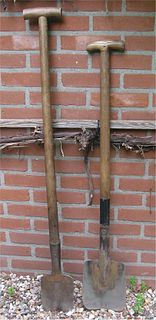
A spade is a tool primarily for digging comprising a blade – typically curved and more pointed than that of a common shovel – and a long handle. Early spades were made of riven wood or of animal bones. After the art of metalworking was developed, spades were made with sharper tips of metal. Before the introduction of metal spades manual labor was less efficient at moving earth, with picks being required to break up the soil in addition to a spade for moving the dirt. With a metal tip, a spade can both break and move the earth in most situations, increasing efficiency.
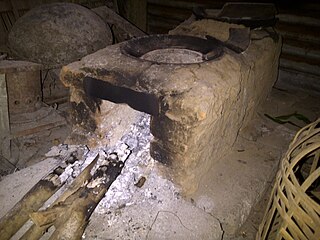
A stove is a device that burns fuel or uses electricity to generate heat inside or on top of the apparatus. It has seen many developments over time and serves the main purpose of cooking food.
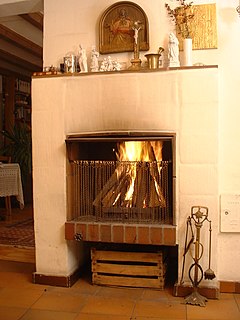
A fireplace or hearth is a structure made of brick, stone or metal designed to contain a fire. Fireplaces are used for the relaxing ambiance they create and for heating a room. Modern fireplaces vary in heat efficiency, depending on the design.

A steam shovel is a large steam-powered excavating machine designed for lifting and moving material such as rock and soil. It is the earliest type of power shovel or excavator. Steam shovels played a major role in public works in the 19th and early 20th century, being key to the construction of railroads and the Panama Canal. The development of simpler, cheaper diesel-powered shovels caused steam shovels to fall out of favor in the 1930s.

A fireman, stoker or watertender is a person whose occupation it is to tend the fire for the running of a boiler, heating a building, or powering a steam engine. Much of the job is hard physical labor, such as shoveling fuel, typically coal, into the boiler's firebox. On steam locomotives the title fireman is usually used, while on steamships and stationary steam engines, such as those driving saw mills, the title is usually stoker. The German word Heizer is equivalent and in Dutch the word stoker is mostly used too. The United States Navy referred to them as watertenders.

The Silver Spade was a giant power shovel used for strip mining in southeastern Ohio. Manufactured by Bucyrus-Erie, South Milwaukee, Wisconsin, the model 1950-B was one of two of this model built, the other being the GEM of Egypt. Its sole function was to remove the earth and rock overburden from the coal seam. Attempts to purchase and preserve the shovel from Consol to make it the centerpiece of a mining museum exhibit for $2.6 million fell short, and the shovel was dismantled in February 2007.
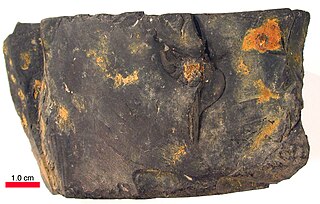
Cannel coal or candle coal is a type of bituminous coal, also classified as terrestrial type oil shale. Due to its physical morphology and low mineral content cannel coal is considered to be coal but by its texture and composition of the organic matter it is considered to be oil shale. Although historically the term cannel coal has been used interchangeably with boghead coal, a more recent classification system restricts cannel coal to terrestrial origin, and boghead coal to lacustrine environments.

A fire iron is any metal instrument for tending a fire.
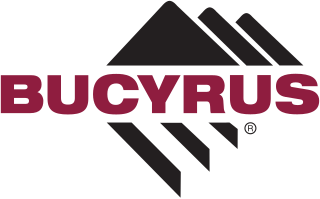
Bucyrus-Erie was an American surface and underground mining equipment company. It was founded as Bucyrus Foundry and Manufacturing Company in Bucyrus, Ohio in 1880. Bucyrus moved its headquarters to South Milwaukee, Wisconsin in 1893. In 1927, Bucyrus merged with the Erie Steam Shovel Company to form Bucyrus-Erie.
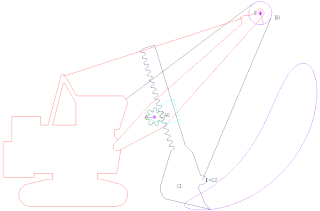
A power shovel is a bucket-equipped machine, usually electrically powered, used for digging and loading earth or fragmented rock and for mineral extraction. Power shovels are a type of rope/cable excavator, where the digging arm is controlled and powered by winches and steel ropes, rather than hydraulics like in the more common hydraulic excavators. Basic parts of a power shovel include the track system, cabin, cables, rack, stick, boom foot-pin, saddle block, boom, boom point sheaves and bucket. The size of bucket varies from 0.73 to 53 cubic meters.
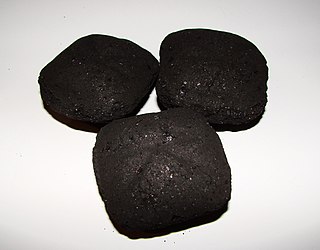
Smokeless fuel is a type of solid fuel which either does not emit visible smoke, or emits minimal amounts, during combustion. These types of fuel are becoming increasingly popular in areas which ban the use of coal and other fuels such as unseasoned or wet wood which produce much smoke. Open fires are still popular with many domestic consumers, especially for those living in older houses where open fireplaces have not been removed or replaced by stoves for example. All houses older than about 1970 are fitted with open fireplaces when coal was in widespread use for domestic heating. However, modern houses are rarely equipped with fireplaces and central heating with natural gas or electricity is the usual choice. As a result of many places banning smoke and pollution, some studies have shown that overall air quality has improved along with fewer annual deaths related to smoke. Many consider smokeless fuel to be the near future replacement of all other solid fuels which cause toxic smoke emissions. The term in general is used to refer to solid fuels, such as: anthracite, coke, charcoal and hexamine fuel tablets. Smoke free carbonaceous fuels are usually supplied in the form of standard pillow-shaped briquettes made from powdered coal or charcoal. Fuel tablets are used by campers and walkers for temporary cooking using a small folding metal stove.
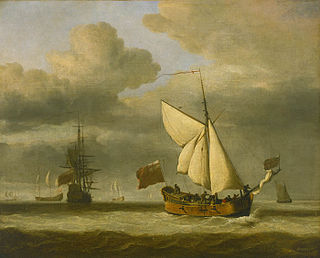
A collier is a bulk cargo ship designed or used to carry coal. Early evidence of coal being transported by sea includes use of coal in London in 1306. In the fourteenth and fifteenth centuries, coal was shipped from the River Tyne to London and other destinations. Other ports also exported coal – for instance the Old Quay in Whitehaven harbour was built in 1634 for the loading of coal. London became highly reliant on the delivery of coal by sea – Samuel Pepys expressed concern in the winter of 1666–67 that war with the Dutch would prevent a fleet of 200 colliers getting through. In 1795, 4,395 cargoes of coal were delivered to London. By 1824, this number had risen to about 7,000; by 1839, it was over 9,000. The trade continued to the end of the twentieth century, with the last cargo of coal leaving the Port of Tyne in February, 2021.
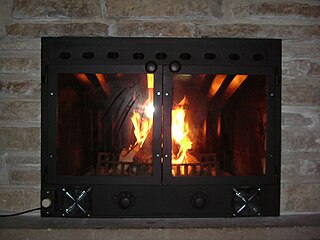
Invented in 1896 by Joab R. Donaldson of Oliphant Furnace, Pennsylvania, US, the fireplace insert is a device inserted into an existing masonry or prefabricated wood fireplace. Joab was a 59-year-old coal miner and father of 14 at the time of his patent. He came upon the idea as a means of using coke and incorporating the use of an electric blower to improve the efficiency. The selection of coke and coal tailings as a primary fuel enabled low-income families to heat their Appalachian homes with small-size coal that they could easily dig for themselves in their own backyards.

A mechanical stoker is a mechanical system that feeds solid fuel like coal, coke or anthracite into the furnace of a steam boiler. They are common on steam locomotives after 1900 and are also used on ships and power stations. Known now as a spreader stoker they remain in use today especially in furnaces fueled by wood pellets or refuse.

The Native American Church (NAC), also known as Peyotism and Peyote Religion, is a Native American religion that teaches a combination of traditional Native American beliefs and Christianity, with sacramental use of the entheogen peyote. The religion originated in the Oklahoma Territory (1890–1907) in the late nineteenth century, after peyote was introduced to the southern Great Plains from Mexico. Today it is the most widespread indigenous religion among Native Americans in the United States, Canada, and Mexico, with an estimated 250,000 adherents as of the late twentieth century.

View-Master Interactive Vision is an interactive movie VHS console game system, introduced in 1988 and released in the USA in 1989 by View-Master Ideal Group, Inc. The tagline is "the Two-Way Television System that makes you a part of the show!" The titles include four Sesame Street games, two games featuring the Muppet Show characters, and a Disney game, Disney's Cartoon Arcade.

Joy Global Inc. was a company that manufactured and serviced heavy equipment used in the extraction and haulage of coal and minerals in both underground and surface mining. The company had manufacturing facilities in Alabama, Pennsylvania, Texas, Wisconsin, Australia, Canada, China, France, South Africa and the United Kingdom. In 2017, Joy Global was acquired by Komatsu Limited and was renamed Komatsu Mining Corp.

The GEM of Egypt was a power shovel used for strip mining. Built in 1966, the machine had worked in the Egypt Valley coalfield, GEM being an acronym for “Giant Earth Mover” or “Giant Excavating Machine”. It was one of only two Bucyrus-Erie 1950-B shovels built and one of two to use the knee action crowd, licensed from Marion Power Shovel in exchange to Marion's use of BE's cable crowd patent.
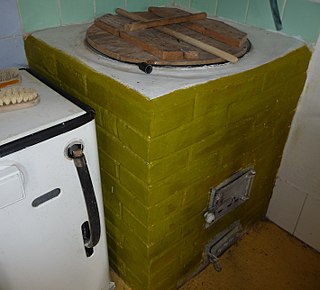
A wash copper, copper boiler or simply copper is a wash house boiler, generally made of galvanised iron, though the best sorts are made of copper. In the inter-war years they came in two types. The first is built into a brickwork furnace and was found in older houses. The second was the free-standing or portable type, it had an enamelled metal exterior that supported the inner can or copper. The bottom part was adapted to hold a gas burner, a high pressure oil or an ordinary wood or coal fire. Superior models could have a drawing-off tap, and a steam-escape pipe that lead into the flue.



















